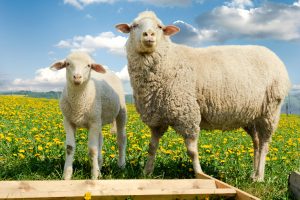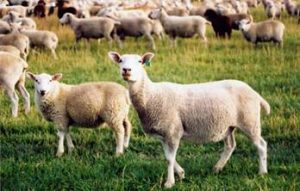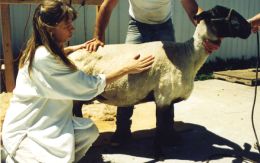Few people have any idea that the North American Wool Industry is disappearing and could be in danger of extinction if the trend were to continue. Only people in the wool industry would have reason to know this. The common person would not. After all, we can still observe sheep grazing contentedly in the countryside’s of North America. Shepherd’s Dream is committed to working with the wool industry to revitalize this precious local & global resource.
Making the Highest-Quality Wool-Filled Bedding
Wool has been used throughout history by many cultures for a myriad of purposes. Wool has historically been used to build homes, as an artistic medium, for clothing, to protect from heat and cold, as flame-proofing, for beds, for toys, for rugs and carpets, in musical instruments, as baby diaper covers, for horse blankets and saddles, and for decorative purposes. One person can raise sheep, harvest wool, wash and spin the fibers and prepare a finished product right from their home. We believe that wool remains an ideal fiber choice for many products – from clothing to bedding. Many of the other materials used in manufacturing are largely derived from petrochemicals – a non-renewable resource that is often imported from unstable regions at a great environmental cost. We have carefully assessed our wool sources to be sure that this is a sustainable and healthy resource. Sheep can damage a landscape. They can also be raised in an inhumane manner. We accept these realities and we still firmly believe that wool is a valuable natural resource that can be produced in a sustainable, thoughtful, cruelty-free manner.
Declining North American Wool Industry
In the middle of the 20th century a wave of synthetic fibers became very popular with manufacturers. Synthetic fibers simplified manufacturing by lacking seasonal or market variation that was common in wool and cotton. In response, the number of sheep being raised in the US began to drop precipitously (sheep populations in the 1990′s were about 10% of 1940′s numbers). In 1966 alone the US saw a 40% drop in the price for wool. Critical infrastructure began to fail as well (such as wool pooling centers and wool washing and processing facilities). Any farmers that continued raising sheep started choosing flocks for lanolin or meat production, wool became a profitless side product. The price of raw wool continued to drop to where it barely covered the farmer’s cost of shearing. In addition to focusing on other aspects of the sheep industry, these farmers found that they needed to raise other crops or find additional jobs to make ends meet. For many shepherds, this marked the end of a way of life. Luckily, wool has made a recent comeback in the commodity market. The US currently contributes less than 1% of the world’s wool clip whereas China, New Zealand, and Australia together account for more than 50%.
 Rebuilding the Wool Industry – Pure Grow Wool
Rebuilding the Wool Industry – Pure Grow Wool
After several years of building beds with organic cotton, wool batting with its comforting and life promoting properties became available to Eliana. This discovery motivated accelerated development of ever healthier bedding and motivated her to find a local wool source. This also led to increasing involvement with the North American wool production industry. Seeing the remarkable healing powers of wool, Eliana was motivated to find a new local source of pure wool batting. Eliana initiated the still successful Pure Grow Wool Program with Sonoma County Woolgrowers in 1993, developing a new paradigm for sustainable and responsible wool production practices.
Supporting Critical Wool Infrastructure
In addition to using domestically produced wool, Shepherd’s Dream LLC is supporting a series of other regional businesses. Raw wool needs to be cleaned and processed before it can be used in most products. As you read earlier, the decline in demand for wool products has caused many of the processing facilities to shut down over the years.
One example of a recent closure is Mt. Jefferson Woolen Mill in Oregon, an almost completely vertical mill (one of the last of its kind in the U.S.). By “Vertical” we mean that Mt. Jefferson had the ability to do everything except wash the wool (they could card wool, make roving, weave and dye cloth). They suddenly closed their doors in the spring of 2001 for “lack of profitability” according to the distant new parent company.
The Sharp family who began this wonderful woolen mill in the 50′s started it with support of local woolgrowers. By the time of their closing almost none of their wool came from the surrounding region.
Purchasing our products supports these domestic processing facilities. They are providing jobs and keeping an important trade alive. With each processing step that takes place in North America, value is added to the wool product and to our economy.
Woolgatherer Carding Mill – a New Kind of Wool
Luckily, there are people like the late Patrick Holland. He was a shepherd of Montague, California, who visited the closing Mt. Jefferson Woolen Mill in Oregon. As a shepherd and a close friend of Shepherd’s Dream LLC’s founder, Patrick Holland was acutely aware of the problems facing the North American wool industry. This knowledge motivated Patrick to purchase the historic carding machinery. This purchase involved transporting and re-assembling 70,000 pounds of carding machinery and learning the art of wool carding from the few remaining skilled millwrights in the country.
A little history will help you to understand why we were so excited about the new carding mill. Since the late 80′s, Eliana had been buying ‘garneted’ wool (similar to ‘carded’, but geared for synthetic and cotton fibers) from a Bay Area garneting mill, which was initially of decent quality. However, by the late 90′s, the poor quality of the wool batting as well as declining customer service had become worrisome. When the quality dropped to an unacceptable quality, she was forced to seek out other options. This is when we stumbled upon Patrick who was having high quality wool carded at a small California mill that could only produce batting up to 60” wide.
After many months of hard work, By February of 2002, Patrick Holland’s new mill was supplying us with beautiful, clean carded wool, purchased at a premium from Oregon and California woolgrowers.
In July of 2002, Shepherd’s Dream LLC moved its store and production facility to Montague, California, in order to consolidate efforts with Woolgatherer Carding Mill. EcoWool, a collaborative project co-founded by Patrick Holland and Shepherd’s Dream LLC, encourages several important things for the future of wool in North America:
- Wool is purchased at premium prices directly from the regional woolgrowers.
- Woolgrowers are encouraged to raise sheep within an evolving set of guidelines which ultimately make the wool more valuable, sustainable and desirable.
- The wool is produced with environmental standards that ensure conscious treatment of the earth and the sheep.
- This wool product fills a niche for consistent high-quality batting that can be used in several different natural product industries.
- This high-quality cottage-industry product is offered at a competitive price.
The Future of Wool in North America



 Rebuilding the Wool Industry – Pure Grow Wool
Rebuilding the Wool Industry – Pure Grow Wool
